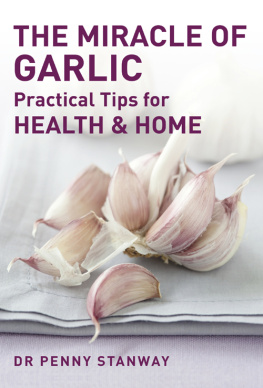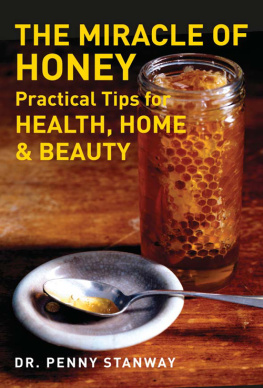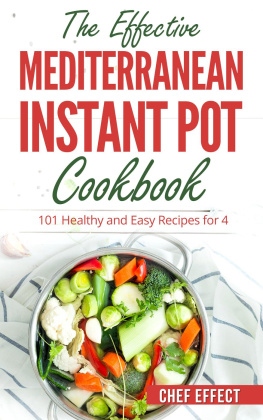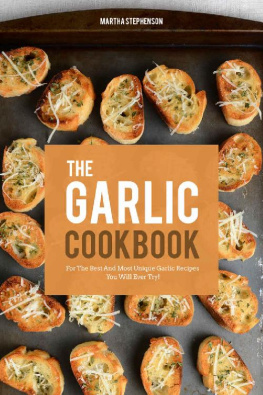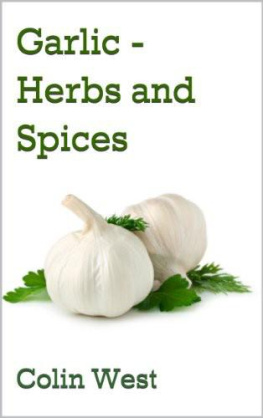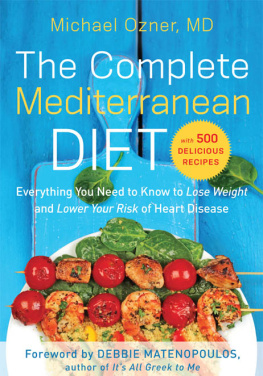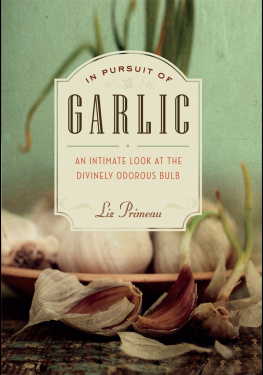THE MIRACLE OF
GARLIC
Practical Tips for
HEALTH AND HOME
DR PENNY STANWAY

Dr Penny Stanway practised for several years as a GP and as a child-health doctor before becoming increasingly fascinated by researching and writing about a healthy diet and other natural approaches to health and wellbeing. She is an accomplished cook who loves eating and very much enjoys being creative in the kitchen and sharing food with others. Penny has written more than 20 books on health, food, and the connections between the two. She lives with her husband in a houseboat on the Thames and often visits the south-west of Ireland. Her leisure pursuits include painting, swimming and being with her family and friends.
By the same author:
The Miracle of Lemons
The Miracle of Cider Vinegar
The Miracle of Bicarbonate of Soda (US The Miracle of Baking Soda)
The Miracle of Olive Oil
The Miracle of Honey
The Natural Guide to Womens Health
Healing Foods for Common Ailments
Good Food for Kids
Free Your Inner Artist
Breast is Best (revised and updated sixth edition, 2012)
As co-author:
Christmas A Cooks Tour
The Lunchbox Book
Feeding Your Baby
Contents
Introduction
Garlic is valued around the world as a flavouring ingredient, a food and a medicine. It belongs to the Alliaceae family, whose 750 species include onions, shallots, chives, leeks and ornamental alliums. The word garlic originates from the Old English for spear (gar) and leek (leac). Its botanical name, Allium sativum, comes from the Greek for avoid (presumably because of its smell) and cultivated. In English alone its many other names include prince of herbs, food of love, nectar of the gods, devils posy, camphor of the poor, poor mans treacle (treacle from the Latin theriaca, meaning antidote to poison or heal all), onion stinker and stinking Jenny/lily/rose.
Todays garlic originated as a wild form in Central Asia more than 10,000 years ago. Over the centuries, this was cultivated and traded along the spice and silk routes to China, the Middle East and the Mediterranean. Eventually it reached Africa, Europe, Australia and the Americas. Today, China produces more than 12 million tonnes (metric tons) a year, which is three-quarters of the global crop. Other top producers, in order of harvest-size, include India, South Korea, Egypt, Russia, the US (especially California), Spain, Argentina, Burma and Ukraine.
Garlics flavour is variously described as pungent, tangy, full, nutty, sweet and musky. Its an important ingredient in many dishes around the world. In Korea and China, the average traditional diet contains 812 cloves a day, while average consumption in the US is half to one clove a day. Some people, though, dislike its flavour as well as the scent that emanates from garlic eaters.
From the time of Ancient Egypt, around 4000 BC , to the end of the 19th century, garlic was the most widely used medicinal plant in the world. It remains a popular traditional remedy for many ailments today. Garlic supplements are among the top-selling herbal supplements in the Western world, and thousands of scientific studies have investigated how garlic can promote good health.
Historically, garlic was also used in the art world: during the 13th17th centuries, gilders used its sticky juice to attach gilding to picture frames and furniture. Nowadays, it is used in industry, too. Garlic oil (isolated by distilling garlic cloves with water) is in big demand because it contains compounds needed for the production of industrial chemicals called alkenes. Alkenes are used for making high-end lubricants, sealants for the glass industry, and binders used in solid propellants for rockets, as well as in the vulcanization of rubber.
Over the millennia, magical powers have been attributed to garlic, and it has been said to protect against vampires, werewolves, witches, sorcerers, demons and evil spirits! Even today some Greek midwives lay garlic in the delivery room to avert the evil eye from the newborn baby, and in some countries people hang garlic outside their home to protect their family.
CHAPTER 1
Garlic Plants
Garlic is a perennial plant with a white, pink, brown or purple-striped bulb called a head. Its bulb is 47.5cm/13in wide and has 425 parts called cloves. Each clove is made of two modified leaves one forming its body, the other its papery wrappings (peel or skin). If you plant a mature clove, it develops into a new garlic plant.
Hardneck Garlic Plants ( Allium sativum ophioscorodon , ophios or serpent garlics )
These plants are called bolters or top-setters because in the summer they produce a thick flower-stalk (scape), the leading end of which bears a papery capsule (topset or umbel) topped with a long point (beak). The stalk may loop or coil up to three times, making it look amazing in a flower arrangement. As it matures, it hardens and straightens. Within the capsule develops a cluster of up to several hundred tiny greenish, pink, red or purple flowers that rarely produce seeds. Among these are clove-like bulbils, numbering from a few to more than a hundred, depending on the variety. If you plant a mature bulbil, it develops into a new garlic plant.
The cloves are larger and easier to peel than those of softneck plants, and are often particularly well flavoured. They are, however, less numerous and cannot be stored for as long.
Varieties include:
Rocamboles 611 cloves with a rich, deep, sweetish flavour. These are many peoples favourite and are excellent raw. They dislike wet soil. They have a thin brownish bulb wrapper that peels easily. They are the shortest-storing garlic (often only 36 months, or 68 if well grown and dried).
Porcelains (Spanish garlic) 46 large cloves with a hot, rich, musky flavour. Their heat is due to a particularly high yield of allicin. They are the hardiest for cool climates, have a thick white bulb wrapper and are the second-longest storing after Silverskins (see ).
Purple Stripe 812 purple-striped cloves with a rich flavour. These are arguably the best garlic for roasting.
Marbled Purple-Stripe as for Purple Stripe.
Glazed Purple-Stripe as for Purple Stripe.
Asiatics bolt only weakly in warmer climates. They have a good flavour and are medium- to long-storing.
Softneck Garlic Plants ( Allium sativum sativum , non-topsetters or non-bolters)
These plants produce a stalk that is only ever semi-stiff, and which softens and bends when the bulb is mature. There are no flowers. There may be a few bulbils above or even inside the bulb.
The cloves tend to be more numerous than those of hardneck plants; they are also longer-storing, smaller and harder to peel.
Varieties include:
Artichokes 1218 cloves with a fairly mild flavour. They can be stored for 69 months, are earlier-maturing than Silverskins and are the most common supermarket garlic in the US.
Silverskins (Italians or Egyptians) up to 24 cloves with a hot flavour. They are later-maturing than Artichokes and are the longest-storing garlics (often 612 months). Their soft stalks plait (braid) well, so are useful for making decorations.

